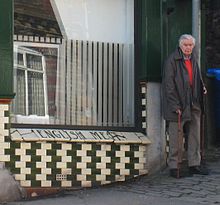Richard Gregory
Richard L. Gregory (born July 24, 1923 in London , † May 17, 2010 in Bristol ) was a British psychologist and neuroscientist , known for investigations into visual perception .
Life
Gregory was the son of the astronomer Christopher Gregory, the first director of the University of London Observatory, and therefore grew up early with optical instruments.
Gregory worked in the Royal Air Force in the field of radar during World War II - immediately afterwards he gave much-attended public lectures on radar on behalf of the Department of Aviation. From 1947 he studied experimental psychology and philosophy at Cambridge University ( Downing College ) (master's degree in 1950). From 1950 he was then a scientist in the group for applied psychology at the University of Cambridge, partly also in the Royal Navy to develop experiments on escaping from sunken submarines. In 1953 he became a demonstrator and then a lecturer at Cambridge. In 1962 he became a Fellow of Corpus Christi College, Cambridge. In 1967 he went to Edinburgh University as Professor of Bionics . He founded the Faculty of Artificial Intelligence and Perception there with Christopher Longuet-Higgins and Donald Michie . 1968 to 1970 he was chairman of the faculty.
From 1970 to 1988 he was director of the Brain and Perception Laboratory in the Medical School of Bristol University ; since 1988 he was Professor Emeritus in the Faculty of Psychology.
He was visiting professor at UCLA (1963), MIT (1964), New York University (1966), the University of California, San Diego , visiting scholar at Bell Laboratories (1973) and Osher Visiting Fellow at the Exploratorium in San Francisco (1989).
Work and honors
Gregory is best known for his investigations into visual perception and its illusions. He also constructed several novel instruments such as a camera that corrects atmospheric turbulence in telescopes and a "Solid Imaging Microscope".
In 1978 he founded the Exploratory Hands-on Science Center in Bristol, the first such science museum in Great Britain, and was its Chairman of the Board (and Honorary Scientific Director) until 1991 and its Director from 1991 to 1999. He also wrote and appeared in numerous TV and radio programs for the BBC, including his Royal Institution Christmas Lectures ( Christmas lectures , in a long tradition since Faraday ) were broadcast in 1969/70 ( The Intelligent Eye ).
In the 1960s he also headed (with the rank of Colonel in the US Air Force) a Special Senses Laboratory, which was supposed to train the Apollo astronauts in the lunar maneuvers for changed perceptual conditions.
With Jean Wallace, he investigated the rare case of an adult who regained his sight after being completely blind ("Recovery from early blindness - a case study", Cambridge 1963). With students, he investigated the primitive visual mechanism (in the manner of the scanning mechanism of a television camera) of Copilia Quadrata copepods , which lives in the depths of the Gulf of Naples.
In 1972 he founded Perception magazine. He is the author of numerous books, his book "Eye and Brain", first published in 1967, became particularly well known.
In 1991 he received the Michael Faraday Prize of the Royal Society. He is a Fellow of the British Psychological Society, the Royal Society of Edinburgh (1969), the Royal Society (1992), the Institute of Physics and the Royal Society of Arts . In 1983 he received a PhD (D.Sc.) from Bristol University. He is also a multiple honorary doctor.
Fonts
- Eye and Brain - on the psychophysiology of seeing, Rowohlt 1991, English original: Eye and Brain - the psychology of seeing, Weidenfeld and Nicholson 1966, 5th edition. Oxford University Press 1997 (and Princeton University Press 1998)
- The Intelligent Eye, Weidenfeld and Nicholson 1970 (from the Royal Institution Christmas Lectures)
- Published in: The Oxford Companion to the Mind, Oxford University Press 1987.
- Mind in Science: a history of explanations of psychology and physics, Weidenfeld and Nicholson 1981.
- Odd Perceptions, Methuen 1986, Routledge 1988 (essays)
- Even Odder Perceptions, Routledge 1994.
- Mirrors in Mind, Freeman / Spektrum and Penguin 1998.
- with Ernst Gombrich : Illusions in Nature and Art, 1973 (catalog of an exhibition from 1970 to 1973 at the Institute of Contemporary Arts and also in San Francisco and New York, co-organizer was Roland Penrose )
- Concepts and mechanisms of perception, Duckworth, London 1974 (collection of his essays)
Web links
- Official website with many of his works online
- His hollow mask deception with Charlie Chaplin is known to a wide audience
References
- ↑ He mentions the physicist Hermann von Helmholtz , who was active in this field in the 19th century, as his greatest role model , Interview in One on One with Richard Gregory. In: The Psychologist. Vol. 21, 2008, issue 6, p. 568.
- ↑ Gregory on Copilia Quadrata
| personal data | |
|---|---|
| SURNAME | Gregory, Richard |
| ALTERNATIVE NAMES | Gregory, Richard L. |
| BRIEF DESCRIPTION | British neuroscientist |
| DATE OF BIRTH | July 24, 1923 |
| PLACE OF BIRTH | London |
| DATE OF DEATH | May 17, 2010 |
| Place of death | Bristol |
